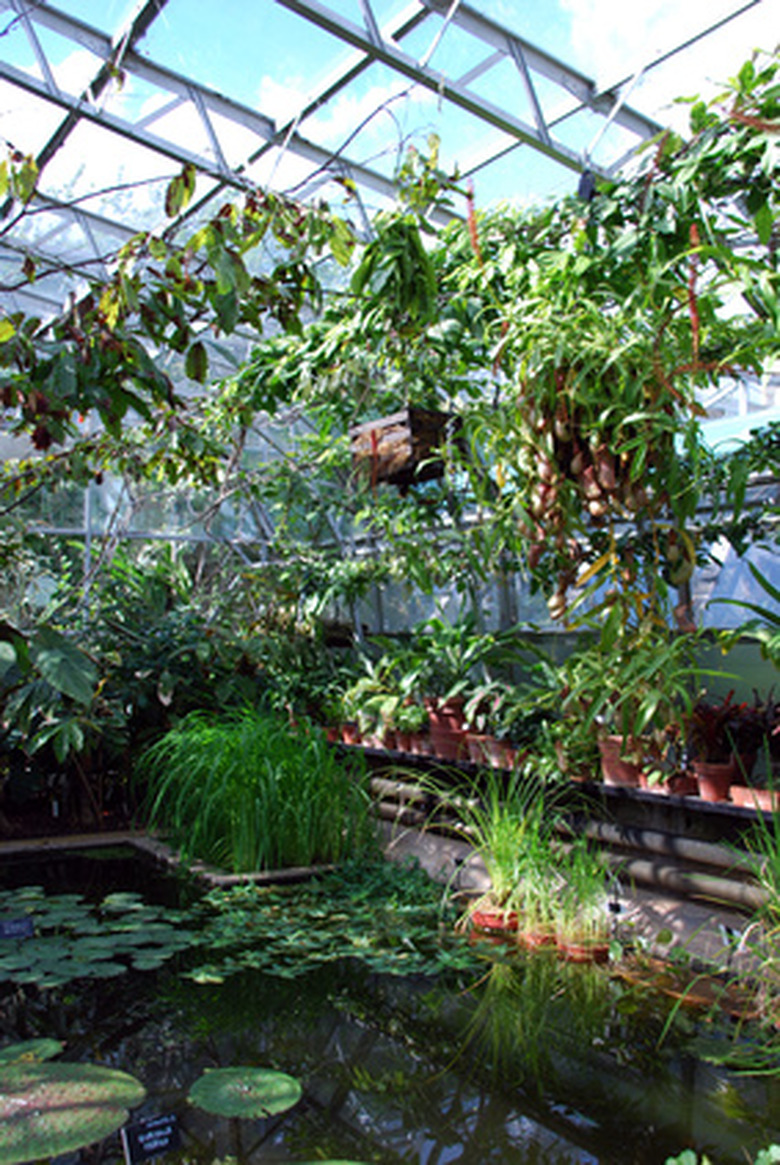Greenhouse Requirements
A greenhouse is very beneficial for the avid gardener, rare plant collector or farmer who wants to grow crops year-round. Several factors are involved in planning or building a successful greenhouse, but the process doesn't have to be very time-consuming or expensive. The main requirements for a successful greenhouse are a proper location and good ventilation, heating, cooling and watering systems.
Location
A greenhouse location is important. The greenhouse must be positioned to get the maximum amount of sunlight; the southeast side of a building is a good spot, because the plants can at least get morning sunlight if there is not a location where they can get full sunlight. The next best locations are east and southwest. If you want your plants to get shade from afternoon sun, the greenhouse location can be east of large deciduous trees. However, keep in mind that you should try to maximize winter sun exposure. The greenhouse must be on level ground.
- A greenhouse is very beneficial for the avid gardener, rare plant collector or farmer who wants to grow crops year-round.
- The greenhouse must be positioned to get the maximum amount of sunlight; the southeast side of a building is a good spot, because the plants can at least get morning sunlight if there is not a location where they can get full sunlight.
Ventilation
Ventilation and air circulation are crucial when controlling a greenhouse. The exchange of indoor and outdoor air keeps the temperature stable and replenishes carbon dioxide. A couple of choices for ventilation are available. Natural ventilation utilizes the ridge line's roof vents along with side vents. With these, the warmer air rises and escapes through the top vents while cool air is swept in through the side vents. Another method, mechanical ventilation, utilizes one to two exhaust fans to transport air out one end of the greenhouse while fresh air comes through the other end through motorized vents. Ventilation requirements vary with the weather and season and also depend on whether the greenhouse is used year-round or not.
- Ventilation and air circulation are crucial when controlling a greenhouse.
- With these, the warmer air rises and escapes through the top vents while cool air is swept in through the side vents.
Cooling
It is important that your greenhouse has a proper cooling system, especially if you use the greenhouse year-round or live in a climate that has extreme seasonal changes. For high summer temperatures, you can lower the greenhouse temperature with methods such as evaporative cooling or shading. Evaporative cooling is basically utilizing small coolers with a fan and an evaporative pad that cools air and increases humidity, while shading is using roll-up screens or vinyl netting to block the sun's heat to a certain degree.
Watering Cycle
Watering is probably the most obvious requirement of greenhouses. This is something you can do manually if you have a small enough area or a lot of time on your hands, but usually different plant varieties in a greenhouse need different times and amounts of watering. You can use a variety of automatic watering systems such as time clocks, mechanical evaporation systems or mist sprays (which make humidity and moisten soils).
Heating
For heating during the winter, two factors to consider are the exposed outside area and the temperature needed in the greenhouse for certain plants. Greenhouse heating systems can be fueled by electricity, gas, oil or wood and can be distributed by methods such as radiant heat, hot air, hot water or steam. Depending on the size of your greenhouse, you can use circuit electric heaters or a small gas/oil heater that doesn't cost a lot of money. And although greenhouses can be heated by solar power, it is less economical than other options and requires a lot of separate space.
- It is important that your greenhouse has a proper cooling system, especially if you use the greenhouse year-round or live in a climate that has extreme seasonal changes.
- Evaporative cooling is basically utilizing small coolers with a fan and an evaporative pad that cools air and increases humidity, while shading is using roll-up screens or vinyl netting to block the sun's heat to a certain degree.
